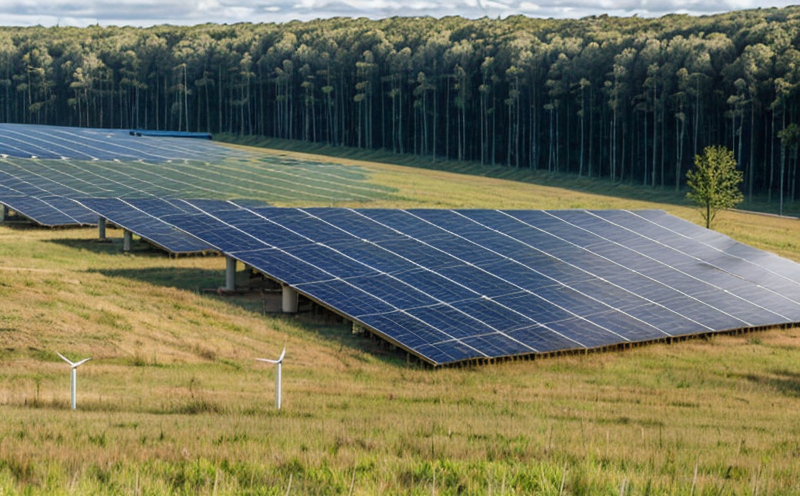ASTM E3012 Life Cycle Assessment of Bioenergy Systems Test
The ASTM E3012 standard provides a structured approach to conducting life cycle assessments (LCAs) for bioenergy systems. This method is essential for evaluating the environmental impacts associated with the entire lifecycle of bioenergy products, from raw material extraction through production, distribution, use, and disposal or recycling.
The ASTM E3012 LCA framework encompasses a detailed methodology to quantify and compare these various stages, enabling stakeholders to make informed decisions about sustainability. By using this standardized approach, organizations can better understand the environmental footprint of their bioenergy systems and identify areas for improvement. This is particularly important in sectors where regulatory compliance and market demand for eco-friendly products are high.
The ASTM E3012 standard focuses on several key aspects:
- Raw material extraction: Assessing the environmental impact of harvesting raw materials used in bioenergy production.
- Production processes: Evaluating the manufacturing and processing stages that contribute to emissions or resource depletion.
- Distribution and supply chain: Analyzing the transportation, packaging, and logistics involved in delivering the final product to end-users.
- Use phase: Measuring the operational impacts during the lifetime of the bioenergy system.
- End-of-life management: Considering how the bioenergy products are managed at the conclusion of their useful lives, including recycling or disposal options.
The ASTM E3012 LCA involves a series of steps to ensure comprehensive and reliable data collection:
- Defining the system boundaries: Clearly identifying which processes are included in the assessment.
- Gathering inventory data: Collecting detailed information on inputs, outputs, and energy use throughout the lifecycle.
- Conducting impact assessments: Applying life cycle impact assessment (LCIA) methods to interpret the environmental impacts of each process.
- Interpreting results: Evaluating the significance of different impacts and identifying opportunities for improvement.
The ASTM E3012 LCA test is critical for several reasons:
- Regulatory Compliance: Many regions have stringent regulations requiring companies to demonstrate the environmental benefits of their products. The ASTM E3012 framework ensures that organizations meet these standards.
- Sustainability Reporting: Organizations can use LCA results as part of their sustainability reporting, providing transparency and accountability to stakeholders.
- Innovation and Improvement: By identifying weak points in the lifecycle, companies can innovate and implement strategies for reducing environmental impacts.
Why It Matters
The importance of ASTM E3012 LCA cannot be overstated, especially in the renewable energy sector. As the world moves toward greater reliance on bioenergy as a sustainable alternative to fossil fuels, it is crucial to understand and mitigate any potential negative environmental impacts. Conducting an LCA helps ensure that bioenergy systems are truly environmentally friendly by providing insights into all stages of their lifecycle.
The ASTM E3012 standard offers several advantages:
- It provides a consistent and transparent methodology for assessing the environmental impact of bioenergy systems.
- It supports decision-making processes by offering data-driven insights into which aspects of the lifecycle have the most significant environmental impacts.
- It facilitates communication between stakeholders, including regulators, manufacturers, and consumers, by providing a common language and framework for discussing sustainability.
Industry Applications
The ASTM E3012 LCA is widely applicable across various sectors within the renewable energy industry. Some key areas include:
- Biofuels production: Assessing the environmental impact of biodiesel and bioethanol from various feedstocks.
- Biogas systems: Evaluating the lifecycle impacts of biogas plants, including methane recovery from agricultural waste.
- Bioenergy crops: Analyzing the sustainability of different bioenergy crops such as switchgrass or miscanthus.
Use Cases and Application Examples
The ASTM E3012 LCA is used in various real-world scenarios to evaluate the environmental impact of bioenergy systems. Some examples include:
- Biofuel Production: A biodiesel plant uses LCA to compare different feedstocks, such as soybean oil and palm oil, for their overall environmental impact.
- Biogas Plants: An anaerobic digestion facility analyzes the lifecycle impacts of biogas production from municipal solid waste versus agricultural residues.
- Bioenergy Crops: A research institute assesses the sustainability of different bioenergy crops by comparing their resource use and emissions across various regions.





